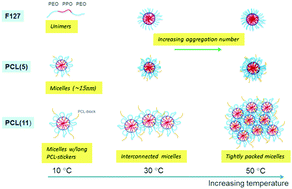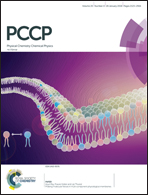Effect of PCL end-groups on the self-assembly process of Pluronic in aqueous media†
Abstract
Understanding self-assembly of amphiphilic copolymers in aqueous solution is an important issue in many areas, e.g., in order to tailor-make carriers for drugs and genes. We have synthesized modified versions of the copolymer of type PEO–PPO–PEO (Pluronic, F127), with short (PCL(5)) or long (PCL(11)) PCL blocks at both ends. Turbidity, dynamic light scattering (DLS), small angle neutron scattering (SANS), and rheology measurements were carried out on dilute aqueous solutions of these polymers to investigate their self-assembly behavior. The DLS results clearly show that both micellization and inter-micellization can be controlled by polymer concentration, temperature, and length of the PCL block. The interplay between unimers, micelles, and clusters of micelles could be monitored and the size and size distribution of the species were determined. The SANS data could be portrayed by a spherical core–shell model at all considered conditions of temperature and concentration for F127 and PCL(5) apart from F127 at the lowest temperature measured. The SANS data for PCL(11) were described by a spherical core–shell model at low temperatures, whereas at elevated temperatures asymmetric sub-structures appeared and a cylindrical core–shell model was employed in the analysis of the data. The appearance of pronounced correlation peaks at elevated temperatures signalizes marked intermicellar interactions. The shear viscosity data revealed a minor shear thinning effect, suggesting that the interchain structures are rather stable and not easily disrupted. The work shows that PCL-modification of Pluronic has a large influence on the self-assembly process and on the final structure of the assemblies.



 Please wait while we load your content...
Please wait while we load your content...